Day 01:
After arriving you will be welcomed by our tour representative in Bagdogra who will be your tour guide during your entire trip in Bhutan. After lunch you will be heading to Phuntsholing Bhutan which is almost 157.4kms (4hours – 5Hours). Check into your hotel in Phuntsholing Bhutan. After check in you will see Phuntsholing city by evening.
Day 02: Drive to Phuntsholing to Paro (165KM/5-6hrs).
Upon reaching Paro if there is time you may visit the few places in Paro as follows:
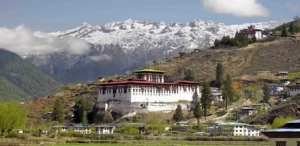
Rimpung Dzhong.
The Paro Dzhong is probably Bhutan’s best known and most iconic Dzhong. This is probably the first building you will notice when you land at Paro International Airport and will probably be your first memory of Bhutan. The imposing Dzhong is perhaps the finest example of Dzhongarchitecture existing the world today, the massive buttered walls of the fortress dominate over the valley. The Rinpung Dzong’s names translates to the “Fortress on a heap of Jewels “.
The fortress was constructed in 1644 by Zhabdrung Ngawang Namgyal on the foundations of an ancient monastery. The fort played a crucial role in the history of the Paro valley as the Dzong helped keep the marauding Tibetans away from the Paro valley.TheDzong was hit by an earthquake in 1897 but survived unharmed, but a fire in 1907 ended up causing severe damage to the Dzong.
The Dzong is built on a steep hill along the banks of the Paro Chu River. The front part of the Dzong is home to the District administration while the other courtyard towards the rare houses the district monk body.
The approach toward the Dzong is through a traditional covered bridge called the Nemi Zam. A paved stone path runs structure. The valley’s annual springtime religious festival called the Paro Tsechu is organized each year in the courtyard of the dzong and is attended by tourists from all over the world.
Ta Dzong (National Museum).
The National Museum of Bhutan is housed inside the six storied circular Ta Dzong. The Ta Dzong is a medieval watch tower situated above the RimpungDzong. The Ta Dzhong was constructed in 1656 with a purpose to give advance warning to the Paro Dzong in case of anapproaching army, in fact the word Ta means ‘to see’ in Dzongkha. The future first king wasimprisoned here for a brief period in 1872.
In 1968 the Ta Dzong was converted into the National Museum of Bhutan. The Museum houses a priceless collection of textile, costumes, paintings, appliqué, wooden handicrafts, weapons, armour and jewellery. There is a small section dedicated to the natural history of Bhutan. There is a small chapel on the top of the building with icons representing HimalayanBuddhist traditions.
Check in Paro Hotel.
Day 03. Taktsang Hike.
After early morning breakfast, we will take you for a morning hike up to Taktsang Monastery, also known as ‘Tiger’s Nest’. Hanging precariously and magically from a rather steep cliff, the Taktshang monastery is a monument of genuine pride for the Bhutanese nation. It defies architectural principles to the core and amazes tourists from around the world. It is a sight to behold.

Taktshang or the Tigers lair as the monastery is called, it is widely regarded is one of the most important monuments of spiritual significance in Bhutan. Its history is deeply associated with the
visit of Guru Padmasambhava, the revered Indian saint who came to Bhutan in the 8th century AD. The cave was named Taktshang after Guru Rinpoche flew into the cave from Kurtoe Singye Dzong in eastern Bhutan while riding on a tigress. When he landed in the cave, he took the wrathful form of Guru Dorji Drolo who is regarded as one of the eight manifestations of Guru Rinpoche to decimate the demons.
From the road, the hike toward Taktshang follows an uphill route and takes approximately 3-4 hours at an average walking pace on a clear, sunny day. We recommend that you carry sunscreen lotion, large quantities of drinking water, a walking stick just in case you need to shoo of the birds and a hat to further protect yourself from the sun.
Kyichu Lhakhang
Later we will visit Kyichu Lhakhang. The Jowo Temple of Kyichu is one of the oldest temples in Bhutan. The temple was built by the Tibetan King SongstenGampo in the 7th Century AD. The Kyichu Lhakhang was one of the 108 temples constructed by him to subdue a demon that was terrorizing the people of the Himalayas. The temple is believed to have been visited by the Guru Rinpoche in the 8th Century during his visit to the Paro Valley. Other important personalities to have visited the temple in antiquity include Lam KhaNga and the PhajoDugomZhigpo.
Over night hotel in Paro.
Day 04: Paro to Thimphu.
After early morning breakfast Drive to Thimphu(54km/1hrs30min).
After lunch you can see following Places;
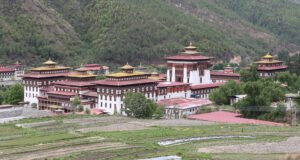
Tashichhodzhong
The TashichhoDzong is a Buddhist monastery cum fortress at the northern edge of Thimpu the capital city of Bhutan. The Dzong was built on the western bank of the river Wang Chu, and has historically served at the seat of the DrukDesi or the Dharma Raja of Bhutan‟s government. After the kings assumed power in 1907 this post was combined with that of the king and Thimphu severed as the summer caital of the kingdom before becoming the full time capital of Bhutan.
The original Thimphu Dzong (the Dho-NgyenDzong) is said to have been constructed in 1216 by Lama GyalwaLhanangpa. And was later taken over by Lama PhajoDrukgomZhigpo before the Dzong was conquered by ZhabdrungNgawangNamgyal, who found the Dzong to be too small and expanded it to what is now known as the Tashichhodzong is also called the “fortress of glorious religion.” It was erected in 1641 and was subsequently rebuilt by King Jigme Dorji Wangchuck in the 1960s.
The Dzong has been seat of the Royal government since 1952 and presently houses the Throne room and the Kings secretariat. The Tashichhodzong is also home to several ministries of the Bhutanese government, and the Central Monk Body which is the apex organization of the country’s main spiritual order. The monument welcomes visitors during the Thimphu Tsechu festival which is held in autumn each year. The Dzongs main structure is a two striped quadrangle with 3 storied towers on each of its four corners.
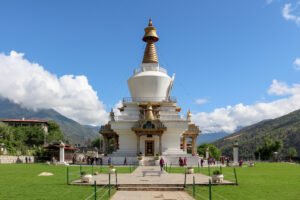
National memorial chorten
The National Memorial was built by Bhutan’s third king, H.M. Jigme Dorji Wangchuck who is also known as the “father of modern Bhutan.” He wanted to erect a monument carrying the message of world peace and prosperity. However, he was unable to give shape to his idea in hislifetime due to pressures of state and other regal responsibilities. After his untimely demise in 1972, the Royal Family and Cabinet resolved to fulfill his wishes and erect a memorial that would perpetuate his memory and also serve as a monument to eternal peace, harmony and tranquility.
The National Memorial Chorten was gifted to the nation on 28 July, 1974. The exquisite wall paintings and the delicately carved statues reflect deep insights into Buddhist spirituality and a rich tradition
of prayer and learning.
The National Memorial Chorten is known as the „most visible religious landmark in Bhutan‟.
The Chorten was consecrated by His Holiness, the Late Dudjorn Rinpoche. Unlike other Stupas the Chorten is not a shrine for the mortal of the late King. The Chorten on contains a photograph of the King in full ceremonial attire. The King had intend for the Choten to be “ a Chorten that represents the mind of Buddha ” The national Memorial Chorten is located in the center of the capital city, Thimphu and is designed like a Tibetan style Chorten. The Chorten is patterned of the classical Stupa design with a pyramidal pillar crowned by a crescent moon and sun. One of the most distinct features of the Chorten is its
outwards flaring rounded part that makes the Chorten look more like a vase rather than the classical dome. The interior of the Chorten has a large number of paintings of Tantric deities, in explicit sexual poses that sometimes can be a little disconcerting to visitors.
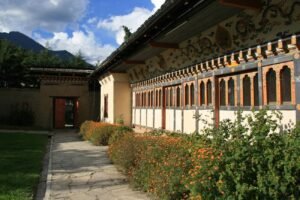
Folk Heritage Museum.
The folk heritage museum was open to the general public in 2001 upon completion. It treasures troves of culture and rich Bhutanese heritage provide rich insights into the Bhutanese ethos. Try to schedule your visit during the morning hours since the museum isless crowded at that time and there is plenty of sunlight to go around.
The folk heritage museum is housed in a replica traditional Bhutanese house learn first-hand about Bhutan‟s rich cultural traditions, its deeply rooted heritage which spans thousands of years and the Bhutanese way of life. The tour of this almost living museum will also give you aglimpse onto how many rural folk of the country live today following the ancient Bhutanese ways.
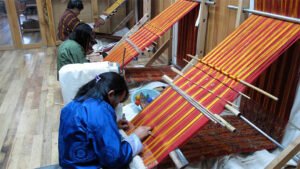
National Textile Museum:
The second important Museum that also opened its doors in 2001 is the National Textile Museum of Bhutan. During a trip to this museum you will get an up close and personal experience of the living national art of weaving. The changing exhibitions at the museum will introduce you to the major weaving techniques that the weavers employ to make these beautiful fabrics. It also gives you a chance to see the various styles of dressing of the men and women from different parts of Bhutan.
The museums exhibits follow 6 major themes:
– Wrap Pattern Weaves
– Weft Pattern Weaves
– Role of Textile in Bhuddism
– Historical achievements in textile
– Textiles made from different indigenous fibers
– The royal textile collection.
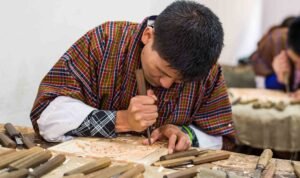
National Institute of Zorig Chusum
The art and crafts currently taught in Bhutan, were introduced to the country in the 15th century by Trenton PemaLingpa. Trenton Pema Lingpa also known as the Great Treasure National Institute for
ZorigChusum – Discoverer is credited to have introduced these art forms to the people of Bhutan. These traditional crafts are a representation of the centuries of knowledge and ability that was been
handed down to master craftsmen and artisan through each generation.
Bhutan‟s unique artistic tradition has played a vital role in shaping the countries distinct culture and heritage. It was realized that this unique and priceless heritage of the nation need to be protected and promoted with the strong patronage of the royal government. With this vision in mind the royal institute for ZoringChusum was established in the year 1971 to train the youth in the 13 traditional Arts and
Crafts of Bhutan.
The institute now falls under the aegis of the National Technical Training Authority which was established in 1990 to ensure high quality vocational training for the people of the country. The institute has now been operational for almost 40 years and has taught students the arts of painting, embroidery, calligraphy, sculpting and wood carving.
Over Night in Thimphu Hotel.
Day: 05 Thimphu – Thimphu
After Breakfast you can visit following Places in Thimphu.
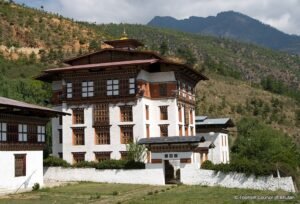
National library
Bhutan’s National Library was established in the 1967. Its mission is to preserve the literary treasures of the nation which constitute a significant element of Bhutan’s rich and vibrant cultural heritage. The library was established with a small collection of precious texts,
Thimphu Bhutan and was housed in the central tower of the TashichoDzhong. The collection then moved to the its present building located in the Changgandkha area of Thimphu. The building that
houses the collection is traditionally constructed four storied eight cornered building that is homage to the central tower temple located in Bhutanese Dzongs.
It houses an extensive collection and archive of Buddhist literary works mostly in ancient block-printed format, with some manuscripts several hundred years old. This collection, which is also known as the “Choekey Collection,” mainly comprises Buddhist literature written in Choekey, the religious script of Northern Buddhism. It also includes works written both in Tibetan and in Dzongkha, Bhutan’s national language. There is also a foreign literature collection which comprises works written in English with subject interest on Buddhist studies, Bhutan, the Himalayan region and neighboring countries like India, Myanmar and Sri Lanka where the Buddhist religion is also practiced.
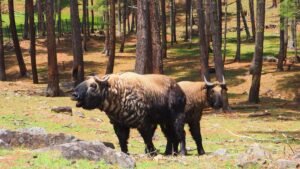
Motithang takin preserve
The MotithangTakin Preserve also known as the Thimphu Zoo by many is a small natural preserve for the Takin Bhutan‟s national animal. It was originally a mini zoo, but it was converted in a preserve later on as the Takin. The mini zoo contained a small number of Takin but the King of Bhutan later decreed that it was improper for a Buddhist nation to keep an animal in captivity. The animals were set free and the zoo was shut down, but for some reason the Takin refused to leave the area for the forests nearby.
The preserve is a forested preserve that mimics the Takin‟s natural habitat, in addition to the Takin there are a few musk deer and barking deer that live inside the preserve. There are plans to expand the
preserves collection to include other rarely seen animals that live in Bhutan, currently the preserve plans to add the Red Panda and the Himalayan Serow to the preserve.

Kuensel phodrang
The KuenselPhodrang or the Buddha point is the world‟s largest sitting Buddha statue, the statue is 167 feet high. The statue is situated on top of a hill overlooking the city of Timphu, it can be accessed by road and is about 15 minutes away from the city‟s center. The word Kuensel means everything is clear and from this place you will sure enjoy a great view of the Thimphu Valley on both sides.
The statue is constructed out of bronze and is studded with many semi-precious stones. Since they are no factories in country that can make such a large bronze cast structure, statute is being manufactured in China and the pieces are brought to Bhutan and are assembled here.
Overnight in Thimphu Hotel.
Day 06. Thimphu to Punakha.
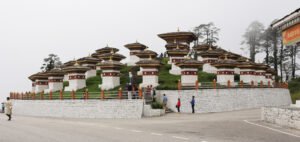
Dochula Pass
Post early breakfast, you will drive towards Punakha via Dochula pass. We will stop over for tea at Dochula (3,100 m), where on a sunny day; you can get stunning views of the Himalayan ranges. The Dochu La Pass is probably the best known mountain pass in Bhutan. Located at an altitude of 3150 meter above sea level, the Dochu La Pass is about 30 kilometer away from the capital city Thimphu and the road to Punakha.
On a clear day the pass offers visitors a spectacular view of the majestic eastern Himalayan Ranges. A cup of hot coffee or tea at the pass has almost become part of tradition for people travelling to and fro from Punakha to the capital city.
There is a small cafeteria at the pass that offers a chance for travelers to enjoy a hot beverage or a snack, it is located just off the road and overlooks the pass and is an ideal place to sit back, relax and enjoy the view. Another striking feature at the pass are the 108 Druk Wangyal Khangzang Chortens, that were built for the well-being of all sentiment beings onearth. The 108 Chorten were built as a tribute to the Kings of Bhutan for their selfless service and leadership they offer to the people of Bhutan. These Stupas or Chortens also represent the peoples love, appreciation and loyalty towards the country‟s King. Then we will drive towards Punakha and visit:-

Punakha Dzong
The Punakha Dzong or the Pungtang Dechen Phortang Dzong is located at the confluence of the Mo Chhu and the Po Chhu River, combine to form the Puna Tsang Chu which in turn is a tributary of the mighty Brahmaputra River. The Dzhong was constructed by Zhabdrung Ngawang Namgyal Wangchuck in 1638 on the exact spot as prophesized by the Guru Rinpoche some 800 years ago.
The Punakha Dzong is the second largest and the second oldest Dzong in Bhutan. The Dzong is home to some of the most sacred relics of the Drukpa Kagyu School of Buddhism; it is also home to the sacred mortal remains of Zhabdrung Nagawang Namgyal and Trenton Pema Lingpa the great treasure discoverer of Bhutan. The Punakha Dzong has also served as the of capital Bhutan till 1955 before the capital was moved toThimphu. The Dzong is still the winter residence of the Je Khenpo (chief abbot) and the central monastic body. The PunakhaDzong plays host to the annual Punakha Theschu Festival which is very popular with the locals and tourists alike.
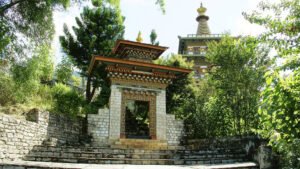
Khamsum Yulley Namgyal Chorten
The YulleyNamgualChorten, lies approximate 7 kilometer north of Punakha. The Chorten is situated along a hill up the valley and can be reached after a leisurely hike through the woods and rice paddies. If you can convince the temple keeper to let you inside with you camera and promise you will not click pictures of the sides of the temple them you will be able to see an awesome view of the Punakha Valley.
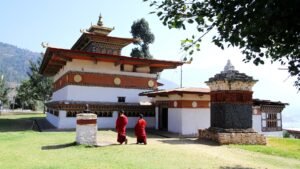
TaloSangaCholing
TaloSangaCholing is located in the Talo valley in the district of Punakha, reach the TaloSangaCholing you take a diversion off the main road towards a secondary road beforeKuruthang. The Monastery was founded by ChogtrulJigmeSingye, the 4th reincarnation of Gyalse Tenzin Ragbye. The temple underwent a renovation and expansion under the 14th Rabjung and the 3rd mind reincarnation of Zhabdrung Ngawang Namgyal, Jigme Dakpa. JigmeDakpa also laid the
foundation of a monastic order to the started from the temple. The Monastery over the centuries has served as the residence of the mind reincarnations of ShabdrungNgawangNamgyal.attepmpts the Shabdrung regained control over the Dzhong when the Dzhongs main building caught fire and its roof collapsed on its occupiers killing them all.
After an early breakfast, we will be driving down to Gantey(Phobjikha). Admire the view en route the valley of Wangdiphodrang. We will drive to ChimmiLhakhang to start with. The Chimi Lhakang or the Chimel Lhakang is a Buddhist monastery located in the Punakha District of
Bhutan. The monastery stands on a small hill close to the village of Lobesa and was constructed in 1499 by NgawangChoegyel, the 14thDrukpaheirarch.
The Temple is very deeply connected to the legends of Saint Drukpa Kinley also known as the Devine Madman. It has been said that the demon of Dochu-La with a magic thunderbolt of wisdom in imprisoned him in a rock close to the temple. DrukpaKuenley is called the Divine Madman due to his unorthodox methods of teaching via songs, humor and sometimes bizarre and shocking behavior with deep sexual overtones. You might be shocked to see that the temple houses a number of wooden phalluses that the Lama had brought with him from Tibet. Pilgrims who visit the monastery receive the blessing by being struck on the head with a ten inch wooden Phallus (erect penis). The
symbol of an erect penis is said to ward off evil.
The monastery is also known as the temple of fertility and is visited not only by the Bhutanese but women from countries as far as Japan and United States to receive a special blessing that can help these women conceive children. These women receive the blessing by getting struck on the head with a 10 inch wooden/ ivory phallus.
The Temple can be accessed by undertaking a short 20 minute walk across the rice fields from the nearest road head. The Lhakhang is a square shaped building with a golden spire on its roof. The temple has many rows of prayer wheels and the temples exterior has embedded slate carvings of various Buddhist saints.
Near the temples entrance there is a small Chorten that marks the spot where the Lamasubdued the demon of Dochu La.

Chendebji chorten
Located 2 kilometers away from the village of Chendebji is the ChendebjiChorten, a large Buddhist Stupa. The Chendebji Chorten is a large white structure built in likeness to the famous Bodhunath Stupa located in Kathmandu in Nepal. The Chorten was constructed by Lama Shinda from Tibet in the 19th century AD. The Stupa is believed to have been constructed at a spot where an evil spirit was subdued by the Lama. Another striking feature of the Temple is the eyes painted at the four cardinal points of the temple.
Overnight in a hotel in Punakha.
Day 07: Punakha to Bagdogra via Phuntsholing Departure.
After early morning breakfast, you will drive to Bagdogra via Phuntsholing.
